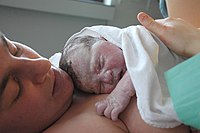
Photo from wikipedia
OBJECTIVE Our aim was to find the factors which predict a vertex presentation of vaginal delivery (VD) in women who are admitted for a trial of external cephalic version (ECV).… Click to show full abstract
OBJECTIVE Our aim was to find the factors which predict a vertex presentation of vaginal delivery (VD) in women who are admitted for a trial of external cephalic version (ECV). STUDY DESIGN This is a retrospective cohort study of women who underwent a trial of ECV and delivered between November 2011 and December 2018 in a single tertiary center. The main outcome measure was successful VD of a fetus in the vertex presentation. Women who achieved VD in the vertex presentation or underwent cesarean delivery were compared on the basis of variety of predictive factors. Adverse neonatal and maternal outcomes were reported. Logistic regression was used for the multivariate analysis. RESULTS A total of 946 women were included; 717 (75.8%) women had a successful ECV and 663 (70.1%) women had a VD in the vertex presentation. Parous women had 79.3% VD rate (570/719) and nulliparous women had 41.0% VD rate (93/227). Women with an amniotic fluid index (AFI) of 50 to 79, 80 to 200, and >200 mm had 34.8, 71.0, and 83.1% VD rate, respectively. Parous versus nulliparous women had an adjusted odds ratio (aOR) of 5.42 (95% confidence interval [CI] 3.90-7.52, p < 0.001), women with AFI 50 to 79 mm compared with AFI 80 to 200 mm had an aOR of 0.21 (95% CI 0.12-0.37, p < 0.001), and women with an AFI >200 mm compared with AFI 80 to 200 mm had an aOR of 1.74 (95% CI 1.03-2.92, p = 0.037) to achieve VD. The final prediction model for the chances of a VD based on data on admission for ECV was reported. The Hosmer-Lemeshow test was used to evaluate the goodness of fit of the model (p = 0.836). CONCLUSION Being parous and having an AFI >200 mm are positive independent predictive factors for achieving VD of a vertex presenting fetus after ECV. Whereas AFI 50 to 79 mm is a negative independent predictive factor. KEY POINTS · The goal of ECV is to achieve a vertex VD.. · Predictors for ECV success might not predict a VD.. · Parity & AFI independently predict a VD after ECV..
Journal Title: American journal of perinatology
Year Published: 2021
Link to full text (if available)
Share on Social Media: Sign Up to like & get
recommendations!